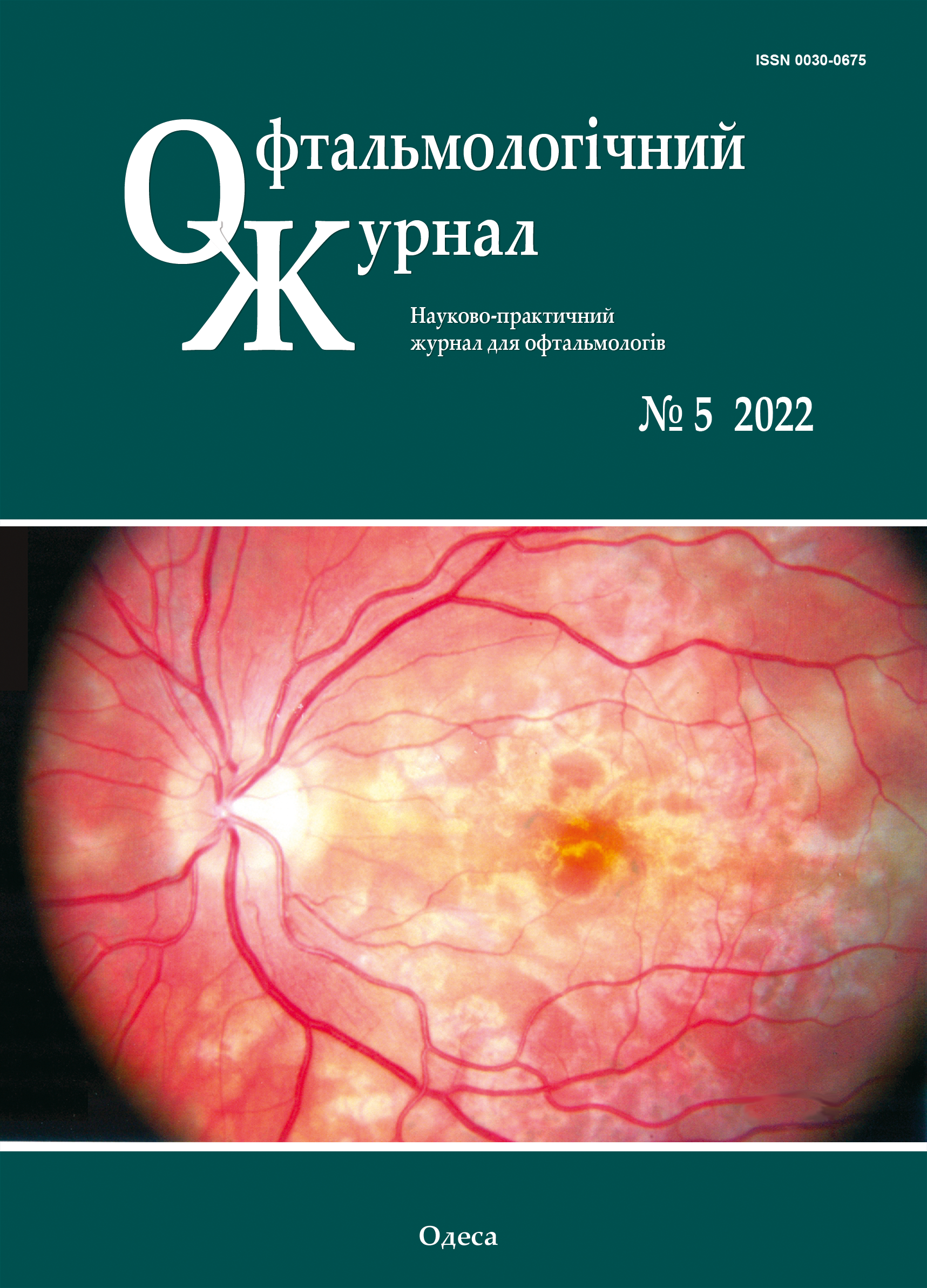Role of polymorphisms of folate-cycle enzymes in diabetic retinopathy progression in patients with type 2 diabetic mellitus
DOI:
https://doi.org/10.31288/oftalmolzh20225311Keywords:
diabetic retinopathy, type 2 diabetes mellitus, folate cycle, homocystein, MTHFR C677T, MTHFR A1298C, MTRA 2756G polymorphismsAbstract
Background: Hyperhomocysteinemia is important in the development of endothelial dysfunction, a pathogenetic component of diabetic retinopathy (DR) in type 2 diabetes mellitus (DM2). The major cause of homocysteine accumulation is missing or dysfunctional enzymes and cofactors that are needed to perform homocystein metabolic processes. This is, for the most part, the deficiency of folate cycle enzymes determined by methylenetetrahydrofolate reductase (MTHFR) C677T, MTHFR A1298C, and methionine synthase (MTR) A2756G polymorphisms.
Purpose: To assess the role of polymorphisms of folate cycle enzymes (MTHFR C677T, MTHFR A1298C, MTR A2756G) in DR progression in patients with DM2.
Material and Methods: The study included 83 DM2 patients (83 eyes) in whom DR met the criteria of non-proliferative diabetic retinopathy (NPDR) or proliferative diabetic retinopathy (PDR) according to the Early Treatment of Diabetic Retinopathy Study (ETDRS). The control group was composed of 35 non-diabetics comparable to patients with respect to gender, age and body mass index. Real-time PCR was conducted on a Gene Amp® PCR System 7500 to determine polymorphisms. Plasma L-homocysteine levels were determined using an enzyme-linked immunosorbent assay (ELISA) microplate reader and Axis® Homocysteine Enzyme Immunoassay Kit (AXIS-SHIELD Diagnostics Ltd).
Conclusion: We found no association of rs1801133, rs1805087, and rs1801131, folate-cycle polymorphisms, with the development of DR in DM2, compared with non-diabetics. In NPDR patients having the minor homozygous GG genotype of MTR 2756А/G and/or the minor homozygous CC genotype of MTHFR 1298A/C, plasma L-homocysteine levels were significantly increased. This requires further elucidation of the role of hyperhomocysteinemia as a factor of DR progression or as a marker of the severity of tissue injury. The duration of DM2 is an important factor of DR progression in carriers of the most common CC and CT genotypes of rs1801133, AG genotype of rs1805087, and АА genotype of rs1801131.
References
1.Barrett EJ, Liu Z, Khamaisi M, et al. Diabetic Microvascular Disease: An Endocrine Society Scientific Statement. J Clin Endocrinol Metab. 2017 Dec 1;102(12):4343-4410. https://doi.org/10.1210/jc.2017-01922
2.Shi C, Wang P, Airen S, et al. Nutritional and medical food therapies for diabetic retinopathy. Eye Vis (Lond). 2020 Jun 18;7:33. https://doi.org/10.1186/s40662-020-00199-y
3.Natrus LV. A novel concept of differences in pathogenetic mechanism of diabetic retinopathy progression between type 2 diabetes mellitus patients differing in the PPARγ genotype. J Ophthalmol (Ukraine). 2020;5:36-42. https://doi.org/10.31288/oftalmolzh202053642
4.Kowluru RA. Diabetic Retinopathy: Mitochondria Caught in a Muddle of Homocysteine. J Clin Med. 2020 Sep 19;9(9):3019. https://doi.org/10.3390/jcm9093019
5.Kowluru, RA, Mohammad G, &Sahajpal N. Faulty homocysteine recycling in diabetic retinopathy. Eye Vis (Lond). 2020 Jan 10;7:4. https://doi.org/10.1186/s40662-019-0167-9
6.Malaguarnera G, Gagliano C, Giordano M, et al. Homocysteine serum levels in diabetic patients with non proliferative, proliferative and without retinopathy. Biomed Res Int. 2014;2014:191497. https://doi.org/10.1155/2014/191497
7.Koklesova L, Mazurakova A, Samec M, et al. Homocysteine metabolism as the target for predictive medical approach, disease prevention, prognosis, and treatments tailored to the person. EPMA J. 2021 Nov 11;12(4):477-505. https://doi.org/10.1007/s13167-021-00263-0
8.Raghubeer S, Matsha TE. Methylenetetrahydrofolate (MTHFR), the One-Carbon Cycle, and Cardiovascular Risks. Nutrients. 2021 Dec 20;13(12):4562. https://doi.org/10.3390/nu13124562
9.Tawfik A, Mohamed R, Elsherbiny N, et al. Homocysteine: A Potential Biomarker for Diabetic Retinopathy. J Clin Med. 2019 Jan; 8(1):121. https://doi.org/10.3390/jcm8010121
10.Mogіlevskyy SIu, Panchenko IuO, Zyablіtsev SV. Predicting the risk of diabetic retinopathy-associated macular edema in patients with type 2 diabetes mellitus. J Ophthalmol (Ukraine). 2019;3:3-8. https://doi.org/10.31288/oftalmolzh2019338
11.Mogіlevskyy SIu, Panchenko IuO, Zyablіtsev SV. Value of TNF-α (rs1800629) polymorphism in recurrent maculopathy after surgery in a Ukrainian population of T2DM patients. J Ophthalmol (Ukraine). 2019;6:15-22. https://doi.org/10.31288/oftalmolzh201961522
12.Panchenko IuO. [Relationship of PDGFB rs1800818 polymorphism with recurrent diabetic maculopathy after surgical treatment in patients with type 2 diabetes mellitus]. Vіsnyk problem bіologії і medytsyny. 2019;4-1(153): 138-42. Ukrainian. https://doi.org/10.29254/2077-4214-2019-4-1-153-138-142
13.Maltsev D, Natrus L. The Effectiveness of Infliximab in Autism Spectrum Disorders Associated with Folate Cycle Genetic Deficiency. Psychiatry, psychotherapy and clinical psychology. 2020; 11(3):581-92. Russian.
14.Maltsev D. Features of folate cycle disorders in children with ASD. Bangladesh Journal of Medical Science. 2020; 19(4):737-42. https://doi.org/10.3329/bjms.v19i4.46634
15.Niu W, Qi Y. An updated meta-analysis of methylenetetrahydrofolate reductase gene 677C/T polymorphism with diabetic nephropathy and diabetic retinopathy. Diabetes Res Clin Pract. 2012, 95(1):110-8. https://doi.org/10.1016/j.diabres.2011.10.009
16.Xu WH, Zhuang Y, Han X, Yuan ZL. Methylenetetrahydrofolate reductase C677T polymorphism and diabetic retinopathy risk: a meta-analysis of the Chinese population. J Int Med Res. 2020;48(1):300060518816834.https://doi.org/10.1177/0300060518816834
17.Luo S, Wang F, Shi C, Wu Z. A Meta-Analysis of Association between Methylenetetrahydrofolate Reductase Gene (MTHFR) 677C/T Polymorphism and Diabetic Retinopathy. Int J Environ Res Public Health. 2016; 13(8):806. https://doi.org/10.3390/ijerph13080806
18.Raza ST, Abbas S, Ahmed F, Fatima J, Zaidi ZH, Mahdi F. Association of MTHFR and PPARγ2 gene polymorphisms in relation to type 2 diabetes mellitus cases among north Indian population. Gene. 2012, 15;511(2):375-9. https://doi.org/10.1016/j.gene.2012.09.072
19.Zhong JH, Rodríguez AC, Yang NN, Li LQ. Methylenetetrahydrofolate reductase gene polymorphism and risk of type 2 diabetes mellitus. PLoS One. 2013 Sep 4;8(9):e74521. https://doi.org/10.1371/journal.pone.0074521
Downloads
Published
How to Cite
Issue
Section
License
Copyright (c) 2025 С. О. Риков, Ю. Прокопенко, Л. В. Натрус, Ю. О. Панченко

This work is licensed under a Creative Commons Attribution 4.0 International License.
This work is licensed under a Creative Commons Attribution 4.0 International (CC BY 4.0) that allows users to read, download, copy, distribute, print, search, or link to the full texts of the articles, or use them for any other lawful purpose, without asking prior permission from the publisher or the author as long as they cite the source.
COPYRIGHT NOTICE
Authors who publish in this journal agree to the following terms:
- Authors hold copyright immediately after publication of their works and retain publishing rights without any restrictions.
- The copyright commencement date complies the publication date of the issue, where the article is included in.
DEPOSIT POLICY
- Authors are permitted and encouraged to post their work online (e.g., in institutional repositories or on their website) during the editorial process, as it can lead to productive exchanges, as well as earlier and greater citation of published work.
- Authors are able to enter into separate, additional contractual arrangements for the non-exclusive distribution of the journal's published version of the work with an acknowledgement of its initial publication in this journal.
- Post-print (post-refereeing manuscript version) and publisher's PDF-version self-archiving is allowed.
- Archiving the pre-print (pre-refereeing manuscript version) not allowed.












